
guerra revolucionaria americana
Prólogo
Ley de sellos
Ley del té
Asedio de boston
Sentido común
Batalla de paoli
Fragua del valle
Batalla de móvil
Tratado de París
Epílogo
apéndices
caracteres
notas al pie
referencias


Visitar tienda
Prólogo
Boston, MA, USA

Ley de sellos
Boston, MA, USA
Actas de acuartelamiento
New York
masacre de boston
Boston
Comités de correspondencia
New England, USA
Ley del té
England, UK
Fiesta del té de boston
Boston, MA
Actos intolerables
London, UK
Primer Congreso Continental
Carpenter's Hall, Philadelphia

Batallas de Lexington y Concord
Middlesex County, Massachusett
asedio de boston
Boston, MA, USA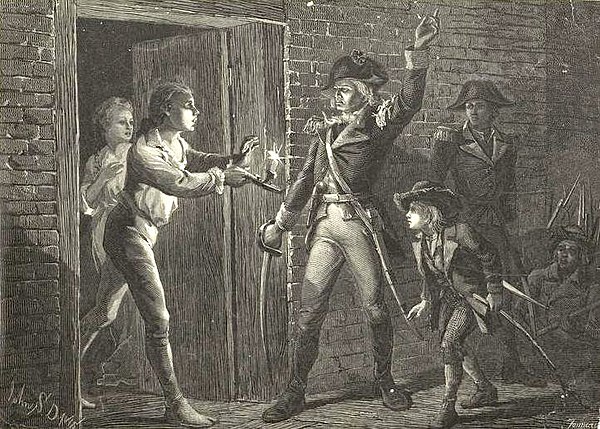
Captura del Fuerte Ticonderoga
Ticonderoga, New York
ejército continental formado
New England
Batalla de Bunker Hill
Charlestown, Boston
Invasión de Quebec
Lake Champlain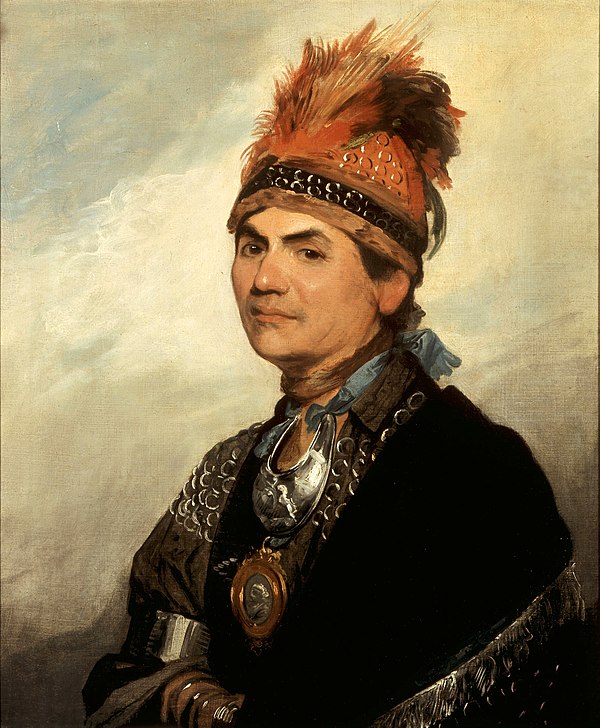
Teatro occidental de la Guerra Revolucionaria Americana
Ohio River, USA
Proclamación de Dunmore
Virginia, USA
Batalla del Gran Puente
Chesapeake, VA, USA
batalla de quebec
Québec, QC, Canada
Sentido común
Philadelphia, PA, USA
Batalla de los botes de arroz
Savannah, GA, USA
Los británicos evacuan Boston
Boston, MA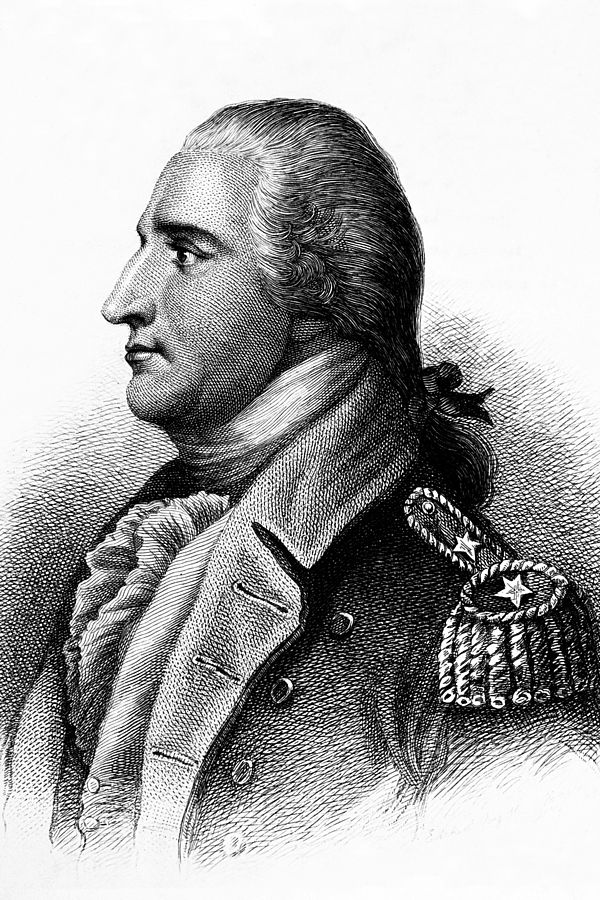
Batalla de los Cedros
Les Cèdres, Quebec, Canada
Batalla de Trois-Rivières
Trois-Rivières, Québec, Canada
Batalla de la isla de Sullivan
Sullivan's Island, South Carol

Campaña de Nueva York y Nueva Jersey
New York, NY, USA
Declaración de Independencia de los Estados Unidos
Philadephia, PA
batalla de isla larga
Brooklyn, NY, USA
Batalla de las alturas de Harlem
Morningside Heights, Manhattan
Batalla de la isla de Valcour
Lake Champlain
Batalla de las Llanuras Blancas
White Plains, New York, USA
Batalla del Fuerte Washington
Washington Heights, Manhattan,
Cruce del río Delaware
Washington's CrossingEl cruce del río Delaware por parte de George Washington , que ocurrió la noche del 25 al 26 de diciembre de 1776, durante la Guerra de Independencia de los Estados Unidos, fue el primer movimiento de un ataque sorpresa organizado por George Washington contra las fuerzas de Hesse (auxiliares alemanes al servicio de la británico) en Trenton, Nueva Jersey, en la mañana del 26 de diciembre. Planificado en secreto parcial, Washington dirigió una columna de tropas del Ejército Continental a través del helado río Delaware en una operación logísticamente difícil y peligrosa.

Batalla de Trenton
Trenton, NJ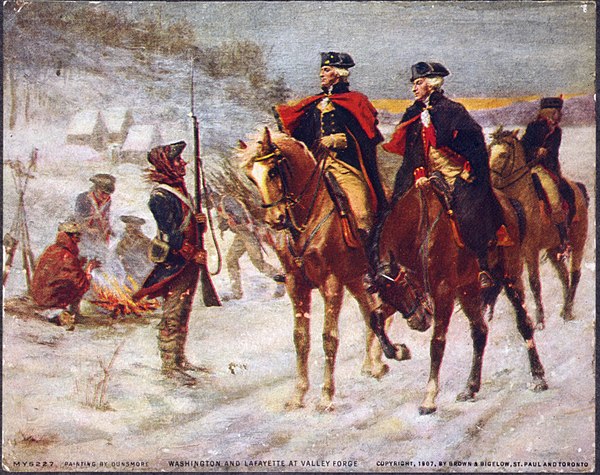
Guerra de forraje
New Jersey, USA
Batalla del arroyo Assunpink
Trenton, New Jersey, USA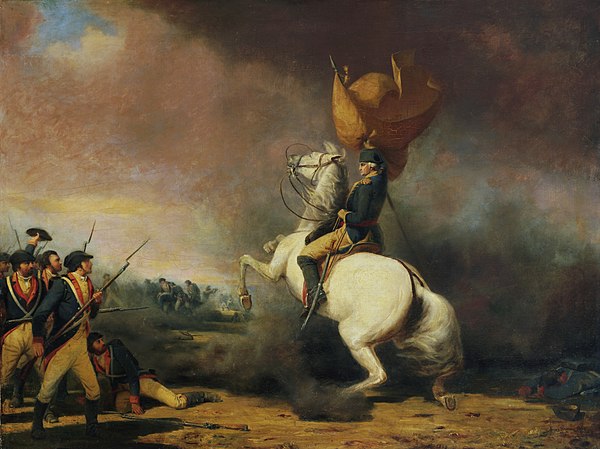
batalla de princeton
Princeton, New Jersey, USA
Batalla de Bound Brook
Bound Brook, New Jersey, U.S.
Incursión de Meigs
Sag Harbor, NY, USA
Campaña de Filadelfia
Philadelphia, PA, USA
Asedio de Fuerte Ticonderoga
Fort Ticonderoga, Fort Ti Road
Batalla de Oriskany
Oriskany, New York, USA

Batalla de Bennington
Walloomsac, New York, USA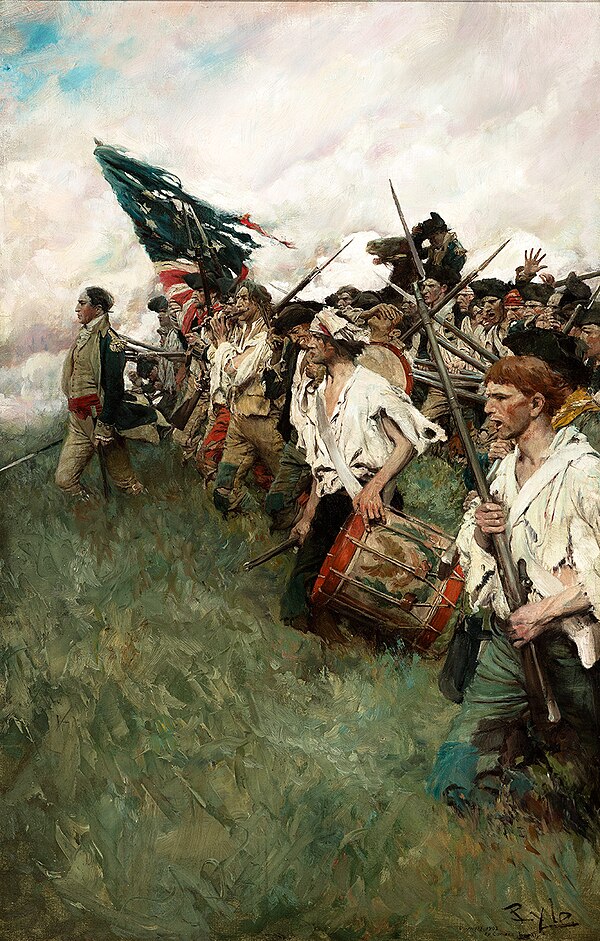
Batalla de Brandivino
Chadds Ford, Pennsylvania, USA
Batallas de Saratoga
Stillwater, Saratogy County
batalla de paoli
Willistown Township, PA, USA
Batalla de Germantown
Germantown, Philadelphia, Penn
Batalla del Banco Rojo
Fort Mercer, Hessian Avenue, N
Batalla de Pantano Blanco
Whitemarsh Township, Montgomer
Fragua del valle
Valley Forge, PA
Tratado de Alianza
Paris, France
Batalla de la colina estéril
Lafayette Hill, PA, USA

Incursiones de Mount Hope Bay
Fall River, Massachusetts, USA
Batalla de Monmouth
Freehold Township, NJ
campaña de Illinois
Illinois, USA
Batalla de Rhode Island
Aquidneck Island, Rhode Island

Los británicos se mudan al sur
Georgia, USA
Masacre del valle de Cherry
Cherry Valley, New York, USA
captura de sabana
Savannah, Georgia
Batalla de Kettle Creek
Washington, Georgia, USA
Asedio de Fort Vincennes
Vincennes, Indiana, USA
Batalla de Brier Creek
Sylvania, Georgia, USA
Incursión de Chesapeake
Chesapeake Bay
España y la Guerra de Independencia de los Estados Unidos
Florida, USA
Expedición Sullivan
Upstate New York, NY, USA
Ferry de la batalla de Stono
Rantowles, South Carolina, USA
La incursión de Tryon
New Haven, CT, USA
Batalla de Stony Point
Stony Point, New York, U.S.
Expedición Penobscot
Penobscot Bay, Maine, USA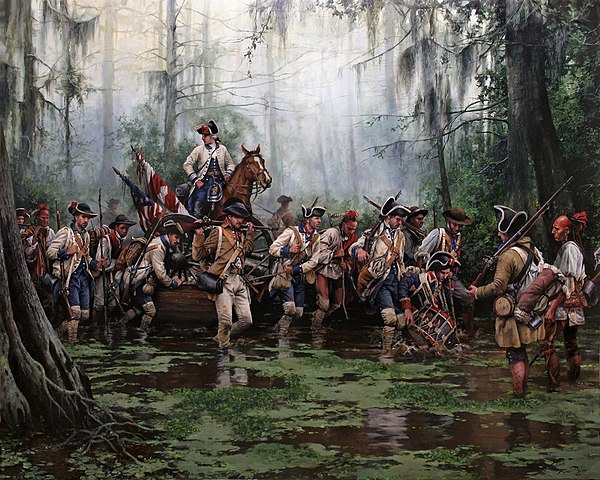
campaña de la costa del golfo
Pensacola, FL, USA
Captura de Fort Bute
East Baton Rouge Parish, LA, U
Batalla del lago Pontchartrain
Lake Pontchartrain, Louisiana,
Batalla de Baton Rouge
Baton Rouge, LA, USALa Batalla de Baton Rouge fue un breve asedio durante la guerra anglo-española que se decidió el 21 de septiembre de 1779. Baton Rouge fue el segundo puesto de avanzada británico en caer en manos de los españoles durante la marcha de Bernardo de Gálvez hacia el oeste británico de Florida.

Asedio de Savannah
Savannah, Georgia, United Stat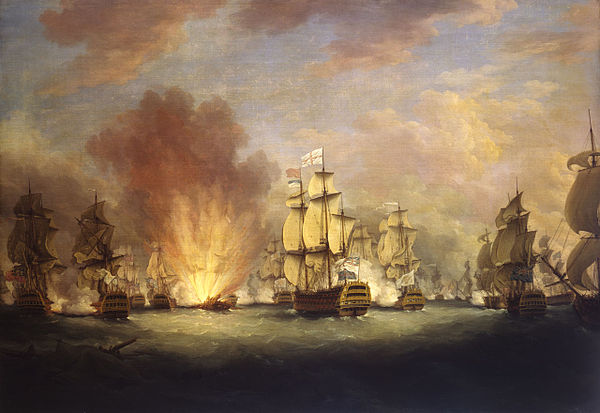
Batalla del Cabo San Vicente
Cape St. Vincent, Sagres, Port
batalla de fuerte charlotte
Mobile, Alabama, USA
Asedio de Charleston
Charleston, South Carolina
Batalla de la esquina de Monck
Moncks Corner, South Carolina,
Batalla de San Luis
St. Louis, MO, USA
Masacre de Waxhaw
Buford, South Carolina, USA
Batalla de las granjas de Connecticut
Union Township, New Jersey, US
Batalla de Springfield
Union County, New Jersey, USA
Batalla de la Roca Colgante
Lancaster County, South Caroli
Batalla de Camden
Kershaw County
Batalla de la Montaña de los Reyes
South Carolina, USA
campaña de yorktown
Yorktown, VA, USA
Batalla de móvil
Mobile, AL, USA
Batalla de corrales de vacas
Cherokee County, South Carolin
Asedio de Pensacola
Pensacola, FL, USA
Batalla del palacio de justicia de Guilford
Greensboro, North Carolina
Asedio de noventa y seis
Ninety Six, South Carolina, US
La derrota de Lochry
Aurora, Indiana, USA
Batalla de Chesapeake
Cape Charles, VA, USA
Batalla de las alturas de Groton
New London Road & Connecticut
Batalla de Eutaw Springs
Eutawville, South Carolina

Asedio de Yorktown
Yorktown, VA
Batalla de Johnstown
Johnstown, New York, USA
batalla de los santos
Dominica
Batalla de Blue Licks
Mount Olivet, Kentucky, USA
Expulsión de los leales
Québec, QC, Canada
Tratado de París
Paris, FranceEpílogo
New England, USAAppendices
APPENDIX 1
American Revolution (1765-1783)

APPENDIX 2
The Birth of the United States Navy

The Navy was rooted in the colonial seafaring tradition, which produced a large community of sailors, captains, and shipbuilders. In the early stages of the American Revolutionary War, Massachusetts had its own Massachusetts Naval Militia. The rationale for establishing a national navy was debated in the Second Continental Congress. Supporters argued that a navy would protect shipping, defend the coast, and make it easier to seek support from foreign countries. Detractors countered that challenging the British Royal Navy, then the world's preeminent naval power, was a foolish undertaking. Commander in Chief George Washington resolved the debate when he commissioned the ocean-going schooner USS Hannah to interdict British merchantmen and reported the captures to the Congress. On 13 October 1775, the Continental Congress authorized the purchase of two vessels to be armed for a cruise against British merchantmen; this resolution created the Continental Navy and is considered the first establishment of the U.S. Navy. The Continental Navy achieved mixed results; it was successful in a number of engagements and raided many British merchant vessels, but it lost twenty-four of its vessels and at one point was reduced to two in active service. In August 1785, after the Revolutionary War had drawn to a close, Congress had sold Alliance, the last ship remaining in the Continental Navy due to a lack of funds to maintain the ship or support a navy.
APPENDIX 3
How Mercantilism Started the American Revolution

APPENDIX 4
Culper Spy Ring

The Culper Ring was a network of spies active during the American Revolutionary War, organized by Major Benjamin Tallmadge and General George Washington in 1778 during the British occupation of New York City. The name "Culper" was suggested by George Washington and taken from Culpeper County, Virginia. The leaders of the spy ring were Abraham Woodhull and Robert Townsend, using the aliases of "Samuel Culper Sr." and "Samuel Culper Jr.", respectively; Tallmadge was referred to as "John Bolton".
While Tallmadge was the spies' direct contact, Washington often directed their operations. The ring was tasked to provide Washington information on British Army operations in New York City, the British headquarters. Its members operated mostly in New York City, Long Island, and Connecticut between late October 1778 and the British evacuation of New York in 1783.
The information supplied by the spy ring included details of a surprise attack on the newly arrived French forces under Lieutenant General Rochambeau at Newport, Rhode Island, before they had recovered from their arduous sea voyage, as well as a British plan to counterfeit American currency on the actual paper used for Continental dollars, which prompted the Continental Congress to retire the bills.
The ring also informed Washington that Tryon's raid of July 1779 was intended to divide his forces and allow Lieutenant General Sir Henry Clinton to attack them piecemeal. In 1780, the Culper Ring discovered a high-ranking American officer, subsequently identified as Benedict Arnold, was plotting with British Major John André to turn over the vitally important American fort at West Point, New York on the Hudson River and surrender its garrison to the British forces.
APPENDIX 5
Von Steuben's Continentals: The First American Army

APPENDIX 6
Riflemen, Snipers & Light Infantry - Continental 'Special Forces' of the American Revolution.

APPENDIX 7
African American Soldiers in the Continental Army

APPENDIX 8
Feeding Washington's Army | Read the Revolution with Ricardo A. Herrera

APPENDIX 9
American Revolution and the French Alliance

Characters

Henry Clinton
British Army Officer
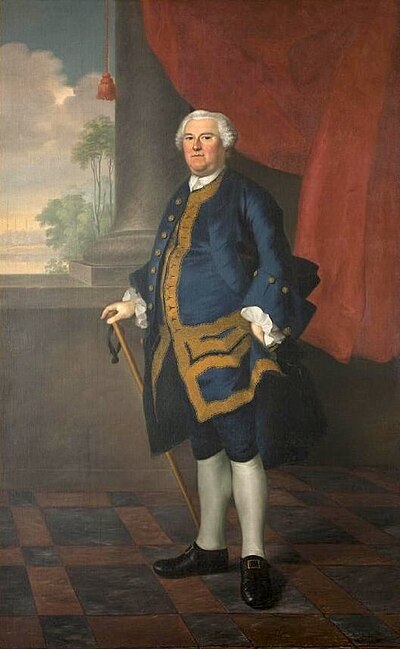
Ethan Allen
American Patriot

Henry Knox
General of the Continental Army

General William Howe
Commander-in-Chief of the British

Patrick Henry
Founding Father

Guy Carleton
Governor of the Province of Quebec
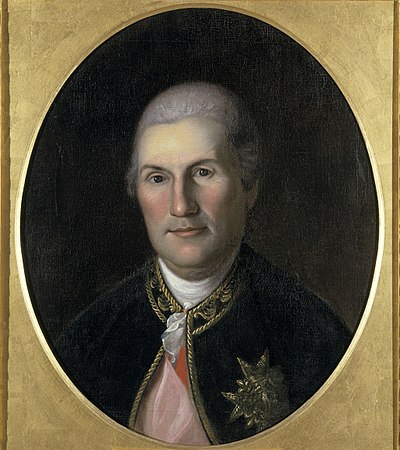
Jean-Baptiste Donatien de Vimeur
Comte de Rochambeau

Banastre Tarleton
British General
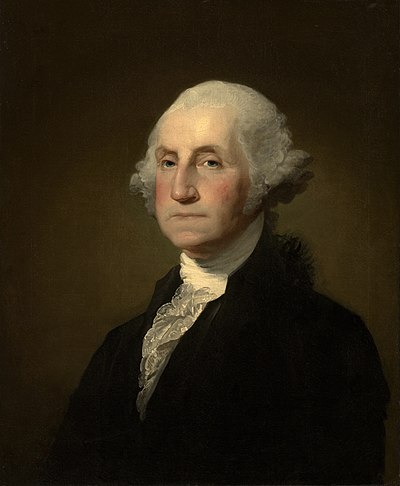
George Washington
Commander of the Continental Army

Mariot Arbuthnot
British Admiral

Paul Revere
American Patriot

Friedrich Wilhelm von Steuben
Prussian Military Officer

John Burgoyne
British General
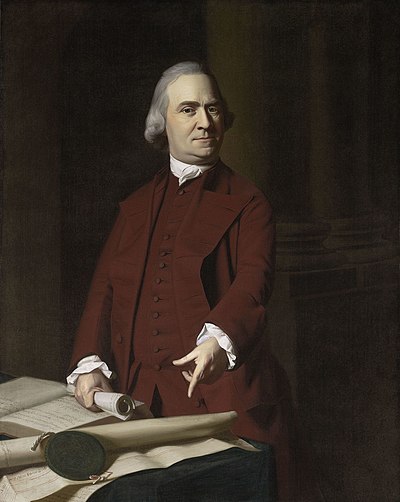
John Hancock
Founding Father

Alexander Hamilton
Founding Father

Nathanael Greene
General of the Continental Army

George III
King of Great Britain and of Ireland

Thomas Jefferson
Founding Father

William Howe
Commander-in-Chief of British Army

William Pitt
British Prime Minister

Horatio Gates
General in the Continental Army
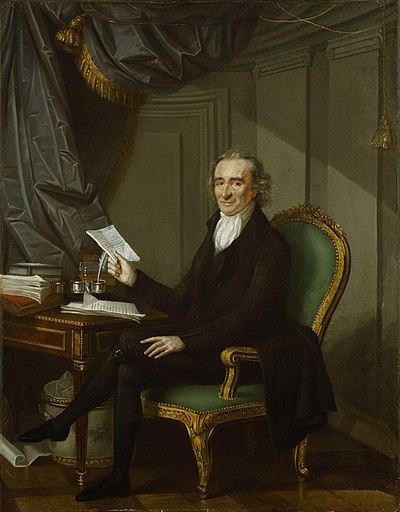
Thomas Paine
American Patriot

Thomas Gage
British Army General

General Charles Cornwallis
British Army General

John Adams
Founding Father

Benedict Arnold
American Military Officer

Benjamin Franklin
Founding Father

John Paul Jones
Patriot Naval Commander
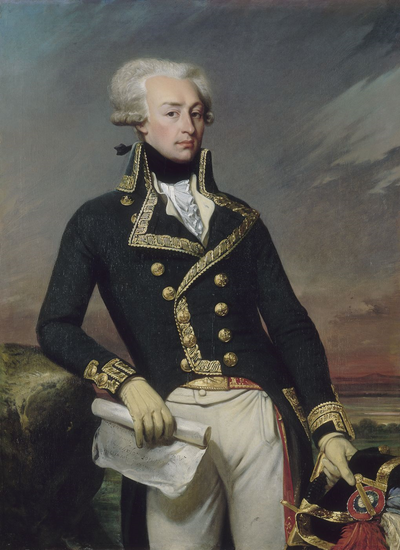
Gilbert du Motier, Marquis de Lafayette
French Military Officer
Footnotes
- Calloway, Colin G. (2007). The Scratch of a Pen: 1763 and the Transformation of North America. Oxford University Press. ISBN 978-0195331271, p. 4.
- Watson, J. Steven; Clark, Sir George (1960). The Reign of George III, 1760–1815. Oxford University Press. ISBN 978-0198217138, pp. 183–184.
- Greene, Jack P.; Pole, J.R. (2008) [2000]. A Companion to the American Revolution. Blackwell Publishers. ISBN 978-0470756447. Collection of essays focused on political and social history, pp. 155–156.
- Morgan, Edmund S.; Morgan, Helen M. (1963). The Stamp Act Crisis: Prologue to Revolution, pp. 96–97.
- Wood, S.G. The American Revolution: A History. Modern Library. 2002, p. 24.
- Testimony of Doctor Benjamin Franklin, before an August Assembly of the British House of Commons, relating to the Repeal of the Stamp-Act, &c., 1766.
- Jenyns, Soame (1765). The Objections to the Taxation of Our American Colonies by the Legislature of Great Britain, Briefly Considered. London, England: J. Wilkie.
- Daniel Dulany, Considerations on the Propriety of Imposing Taxes in the British Colonies, for the Purpose of Raising a Revenue, by Act of Parliament (1765)(reprinted in The American Revolution, Interpreting Primary Documents 47–51 (Carey 2004)).
- Draper, Theodore (1996). A Struggle For Power: The American Revolution. ISBN 0812925750, pp. 216–223.
- Gordon Wood, The American Revolution (New York: Random House, 2002).
- "Tea Act | Great Britain [1773]",Encyclopaedia Britannica.
- "Boston Massacre", Encyclopaedia Britannica.
- Albert Bushnell Hart (1897). Formation of the Union. p. 49. ISBN 9781406816990.
- Norton, Mary Beth; Blight, David W. (2001). A People and a Nation. Vol. 1 (6th ed.). Houghton Mifflin. ISBN 978-0-618-21469-3, pp. 144–145.
- Smith, George (January 17, 2012). The Boston tea party. The institute for humane studies and libertarianism.org.
- Sosin, Jack M. (June 12, 2022). "The Massachusetts Acts of 1774: Coercive or Preventive". Huntington Library Quarterly. 26 (3): 235–252. doi:10.2307/3816653. JSTOR 3816653.
- Mitchell, Stacy. The big box swindle.
- Sosin, Jack M. (12 June 2022). "The Massachusetts Acts of 1774: Coercive or Preventive". Huntington Library Quarterly. 26 (3): 235–252. doi:10.2307/3816653. JSTOR 3816653.
- James L. Nelson, With Fire and Sword: The Battle of Bunker Hill and the Beginning of the American Revolution (2011).
- Borneman, Walter R. American Spring: Lexington, Concord, and the Road to Revolution, p. 350, Little, Brown and Company, New York, Boston, London, 2014. ISBN 978-0-316-22102-3.
- Hubbard, Robert Ernest. Major General Israel Putnam: Hero of the American Revolution, pp. 85–87, McFarland & Company, Inc., Jefferson, North Carolina, 2017. ISBN 978-1-4766-6453-8.
- Withington, Robert (June 1949). "A French Comment on the Battle of Bunker Hill". The New England Quarterly. 22 (2): 235–240. doi:10.2307/362033. ISSN 0028-4866. JSTOR 362033.
- Hubbard, Robert Ernest. Major General Israel Putnam: Hero of the American Revolution, pp. 87–95, McFarland & Company, Inc., Jefferson, North Carolina, 2017. ISBN 978-1-4766-6453-8.
- Clinton, Henry (1954). Willcox, William B. (ed.). The American Rebellion: Sir Henry Clinton's Narrative of His Campaigns, 1775–1782. Yale University Press. OCLC 1305132, p. 19. General Clinton's remark is an echoing of Pyrrhus of Epirus's original sentiment after the Battle of Heraclea, "one more such victory and the cause is lost".
- McCullough, David (2005). 1776. Simon and Schuster Paperback. ISBN 0-7432-2672-0, p. 104.
- Frothingham Jr, Richard (1851). History of the Siege of Boston and of the Battles of Lexington, Concord, and Bunker Hill. Little and Brown, p. 308.
- Frothingham, p. 309.
- McCullough, p. 105.
- Maier, Pauline (1998). American scripture: making the Declaration of Independence. Vintage Books. ISBN 978-0679779087., pp. 33–34.
- McCullough 2005, pp. 119–122.
- "The Declaration House Through Time", National Park Services.
- Ferling 2007. Almost a Miracle. Oxford University Press. ISBN 978-0199758470, pp. 112, 118.
- Maier 1998, pp. 160–61.
- Fischer, David Hackett (2004). Washington's Crossing. Oxford University Press. ISBN 978-0195170344, p. 29.
- Mays, Terry M. (2016). Historical Dictionary of the American Revolution. Rowman & Littlefield. ISBN 978-1538119723., p. 2.
- Mays 2019, p. 3.
- Greene, Jack P.; Pole, J.R. (2008) [2000]. A Companion to the American Revolution. Blackwell Publishers. ISBN 978-0470756447. Collection of essays focused on political and social history, p. 235.
- Ketchum, Richard (1999). The Winter Soldiers: The Battles for Trenton and Princeton. Holt Paperbacks; 1st Owl books ed edition. ISBN 0-8050-6098-7, p.111.
- Burrows, Edwin G. and Wallace, Mike (1999). Gotham: A History of New York City to 1898. New York: Oxford University Press. ISBN 0-195-11634-8., p.243.
- Lengel, Edward (2005). General George Washington. New York: Random House Paperbacks. ISBN 0-8129-6950-2. General George Washington Lengel, p.165.
- The American Revolution: A Visual History. DK Smithsonian. p. 125.
- The Battle of Bennington: Soldiers & Civilians By Michael P. Gabriel.
- Harris, Michael (2014). Brandywine. El Dorado Hills, CA: Savas Beatie. p. x. ISBN 978-1-61121-162-7.
- Harris, Michael (2014). Brandywine: A Military History of the Battle that Lost Philadelphia but Saved America, September 11, 1777. El Dorado Hills, CA: Savas Beatiuùuù hie. p. 55. ISBN 978-1-61121-162-7.
- Morgan, Edmund (1956). The Birth of the Republic: 1763–1789. [Chicago] University of Chicago Press. pp. 82–83.
- Murray, Stuart A. P. (2006). Smithsonian Q & A: The American Revolution. New York: HarperCollins. ISBN 9780060891138. OCLC 67393037, p. 64.
- Graymont, Barbara (1972). The Iroquois in the American Revolution. Syracuse, NY: Syracuse University Press. ISBN 0-8156-0083-6, p. 186.
- Mikaberidze, Alexander (June 25, 2013). "Atrocities, Massacres, and War Crimes: An Encyclopedia [2 volumes]: An Encyclopedia". ABC-CLIO. Though persuaded to remain, Brant exercised no authority over the raid (nor the regiment).
- Williams, Dave. "Kettle Creek Battlefield Wins National Park Service Designation". Georgia Public Broadcasting.
- Thomas E. Chavez (January 2004). Spain and the Independence of the United States: An Intrinsic Gift. UNM Press. p. 225. ISBN 978-0-8263-2794-9.
- Fernández y Fernández, Enrique (1985). Spain's Contribution to the independence of the United States. Embassy of Spain: United States of America, p. 4.
- Soodalter, Ron (July 8, 2011). "Massacre & Retribution: The 1779–80 Sullivan Expedition". World History Group.
- Koehler, Rhiannon (Fall 2018). "Hostile Nations: Quantifying the Destruction of the Sullivan-Clinton Genocide of 1779". American Indian Quarterly. 42 (4): 427–453. doi:10.5250/amerindiquar.42.4.0427. S2CID 165519714.
- Anderson, Fred (2004). George Washington Remembers: Reflections on the French and Indian War. Rowman & Littlefield. p. 138. ISBN 978-0-7425-3372-1.
- "A well-executed failure: the Sullivan campaign against the Iroquois, July–September, 1779". Choice Reviews Online. 35 (01): 35–0457-35-0457. September 1, 1997. doi:10.5860/choice.35-0457. ISSN 0009-4978.
- George P. Clark (1980). "The Role of the Haitian Volunteers at Savannah in 1779: An Attempt at an Objective View". Phylon. 41 (4): 356–366. doi:10.2307/274860. JSTOR 274860.
- Davis, Robert Scott (22 February 2021). "Black Haitian Soldiers at the Siege of Savannah". Journal of the American Revolution.
- Bass, Robert.D (August 1957). The Green Dragoon: The Lives of Banastre Tarleton and Mary Robinson. North Carolina Office of Archives and History. pp. 79–83. ISBN 0878441638.
- Fleming, Thomas (1973). The Forgotten Victory: The Battle for New Jersery – 1780. New York: Reader's Digest Press. ISBN 0-88349-003-X, p. 232.
- Fleming, p. 232, 302.
- "The American revolution revisited". The Economist. 29 June 2017.
- Babits, Lawrence E.; Howard, Joshua B. (2009). Long, Obstinate, and Bloody: The Battle of Guilford Courthouse. The University of North Carolina Press. p. 122.
- "Guilford Courthouse National Military Park". Museum Management Program. National Park Service, U.S. Department of the Interior. 6 June 2002.
- Duffy, Michael (1992). Parameters of British Naval Power, 1650–1850. University of Exeter Press. ISBN 978-0-85989-385-5, p. 110.
- Tucker, Spencer C (2018). American Revolution: The Definitive Encyclopedia and Document Collection. ABC-CLIO. ISBN 9781851097449, p. 1323.
- O'Shaughnessy, Andrew (2013). The Men Who Lost America: British Command during the Revolutionary War and the Preservation of the Empire. Oneworld Publications. ISBN 9781780742465, p. 314.
- Allison & Ferreiro 2018, p. 220: This reversal had a significant effect on peace negotiations to end the American revolution which were already underway and would lead to an agreement by the end of the year.
- Paterson, Thomas; Clifford, J. Garry; Maddock, Shane J. (January 1, 2014). American foreign relations: A history, to 1920. Vol. 1. Cengage Learning. p. 20. ISBN 978-1305172104.
- Morris, Richard B. (1965). The Peacemakers: the Great Powers and American Independence. Harper and Row.
- "Treaties in Force A List of Treaties and Other International Agreements of the United States in Force on January 1, 2016" (PDF). United States Department of State. p. 477.
References
- Allison, David, and Larrie D. Ferreiro, eds. The American Revolution: A World War (Smithsonian, 2018) excerpt
- Bancroft, George (1854–1878). History of the United States of America, from the discovery of the American continent – eight volumes.
- Volumes committed to the American Revolution: Vol. 7; Vol. 8; Vol. 9; Vol. 10
- Bobrick, Benson. Angel in the Whirlwind: The Triumph of the American Revolution. Penguin, 1998 (paperback reprint)
- British Army (1916) [7 August 1781]. Proceedings of a Board of general officers of the British army at New York, 1781. New-York Historical Society. Collections. The John Watts de Peyster publication fund series, no. 49. New York Historical Society. The board of inquiry was convened by Sir Henry Clinton into Army accounts and expenditures
- Burgoyne, John (1780). A state of the expedition from Canada : as laid before the House of commons. London : Printed for J. Almon.
- Butterfield, Lyman H. (June 1950). "Psychological Warfare in 1776: The Jefferson-Franklin Plan to Cause Hessian Desertions". Proceedings of the American Philosophical Society. American Philosophical Society. 94 (3): 233–241. JSTOR 3143556.
- Cate, Alan C. (2006). Founding Fighters: The Battlefield Leaders Who Made American Independence. Greenwood Publishing Group. ISBN 0275987078.
- Caughey, John W. (1998). Bernardo de Gálvez in Louisiana 1776–1783. Gretna: Pelican Publishing Company. ISBN 978-1-56554-517-5.
- Chartrand, Rene. The French Army in the American War of Independence (1994). Short (48pp), very well illustrated descriptions.
- Christie, Ian R.; Labaree, Benjamin W. (1976). Empire or independence, 1760–1776. Phaidon Press. ISBN 978-0-7148-1614-2.
- Clarfield, Gerard (1992). United States Diplomatic History: From Revolution to Empire. New Jersey: Prentice-Hall. ISBN 9780130292322.
- Clode, Charles M. (1869). The military forces of the crown; their administration and government. Vol. 2. London, J. Murray.
- Commager, Henry Steele and Richard B. Morris, eds. The Spirit of 'Seventy-Six': The Story of the American Revolution as told by Participants. (Indianapolis: Bobbs-Merrill, 1958). online
- Conway, Stephen. The War of American Independence 1775–1783. Publisher: E. Arnold, 1995. ISBN 0340625201. 280 pp.
- Creigh, Alfred (1871). History of Washington County. B. Singerly. p. 49. ann hupp indian.
- Cook, Fred J. (1959). What Manner of Men. William Morrow and Co. 59-11702. Allan McLane, Chapter VIII, pp. 275–304
- Davies, Wallace Evan (July 1939). "Privateering around Long Island during the Revolution". New York History. Fenimore Art Museum. 20 (3): 283–294. JSTOR 23134696.
- Downes, Randolph C. (1940). Council Fires on the Upper Ohio: A Narrative of Indian Affairs in the Upper Ohio Valley until 1795. Pittsburgh: University of Pittsburgh Press. ISBN 0-8229-5201-7.
- Duncan, Francis (1879). History of the Royal Regiment of Artillery. London: John Murray.
- Ferling, John E. (2002) [2000]. Setting the World Ablaze: Washington, Adams, Jefferson, and the American Revolution. Oxford University Press. ISBN 978-0-19-513409-4.
- Fleming, Thomas (1970). The Perils of Peace. New York: The Dial Press. ISBN 978-0-06-113911-6.
- Foner, Eric, "Whose Revolution?: The history of the United States' founding from below" (review of Woody Holton, Liberty Is Sweet: The Hidden History of the American Revolution, Simon & Schuster, 2021, 800 pp.), The Nation, vol. 314, no. 8 (18–25 April 2022), pp. 32–37. Highlighted are the struggles and tragic fates of America's Indians and Black slaves. For example, "In 1779 [George] Washington dispatched a contingent of soldiers to upstate New York to burn Indian towns and crops and seize hostages 'of every age and sex.' The following year, while serving as governor of Virginia, [Thomas] Jefferson ordered troops under the command of George Rogers Clark to enter the Ohio Valley and bring about the expulsion or 'extermination' of local Indians." (pp. 34–35.)
- Fortescue, John (1902). A history of the British army. Vol. 3.
- Fredriksen, John C. (2006). Revolutionary War Almanac Almanacs of American wars Facts on File library of American history. Infobase Publishing. ISBN 978-0-8160-7468-6.
- Freedman, Russell (2008). Washington at Valley Forge. Holiday House. ISBN 978-0823420698.
- Fremont-Barnes, Gregory; Ryerson, Richard A, eds. (2006). Encyclopedia of the American Revolutionary War: A Political, Social, and Military History. ABC-CLIO. ISBN 978-1851094080.
- Frey, Sylvia R (1982). The British Soldier in America: A Social History of Military Life in the Revolutionary Period. University of Texas Press. ISBN 978-0292780408.
- Gilbert, Alan (2012). Black Patriots and Loyalists: Fighting for Emancipation in the War for Independence. University of Chicago Press. ISBN 978-0226101552.
- Grant, John N. (1973). "Black Immigrants into Nova Scotia, 1776–1815". The Journal of Negro History. 58 (3): 253–270. doi:10.2307/2716777. JSTOR 2716777. S2CID 150064269.
- Jensen, Merrill (2004). The Founding of a Nation: A History of the American Revolution 1763–1776. Hackett Publishing. ISBN 978-0-87220-705-9.
- Johnston, Henry Phelps (1881). The Yorktown Campaign and the Surrender of Cornwallis, 1781. New York: Harper & Bros. p. 34. OCLC 426009.
- Hagist, Don N. (Winter 2011). "Unpublished Writings of Roger Lamb, Soldier of the American War of Independence". Journal of the Society for Army Historical Research. Society for Army Historical Research. 89 (360): 280–290. JSTOR 44232931.
- Kaplan, Rodger (January 1990). "The Hidden War: British Intelligence Operations during the American Revolution". The William and Mary Quarterly. Omohundro Institute of Early American History and Culture. 47 (1): 115–138. doi:10.2307/2938043. JSTOR 2938043.
- Kepner, K. (February 1945). "A British View of the Siege of Charleston, 1776". The Journal of Southern History. Southern Historical Association. 11 (1): 93–103. doi:10.2307/2197961. JSTOR 2197961.
- Kilmeade, Brian.; Yaeger, Don (2013). George Washington's Secret Six: The Spy Ring That Saved the American Revolution. Penguin Books. ISBN 978-0-6981-3765-3.
- Knight, Peter (2003). Conspiracy Theories in American History: An Encyclopedia. ABC-CLIO. pp. 184–85. ISBN 978-1-57607-812-9.
- Kohn, George C. (2006). Dictionary of Wars, 3d edition. Infobase Publishing. ISBN 9781438129167.
- Kwasny, Mark V. Washington's Partisan War, 1775–1783. Kent, Ohio: 1996. ISBN 0873385462. Militia warfare.
- Larabee, Leonard Woods (1959). Conservatism in Early American History. Cornell University Press. ISBN 978-0151547456. Great Seal Books
- Lemaître, Georges Édouard (2005). Beaumarchais. Kessinger Publishing. ISBN 9781417985364.
- Levy, Andrew (2007). The First Emancipator: Slavery, Religion, and the Quiet Revolution of Robert Carter. Random House Trade Paperbacks. p. 74. ISBN 978-0-375-76104-1.
- Library of Congress "Revolutionary War: Groping Toward Peace, 1781–1783". Library: Library of Congress. Library of Congress. Retrieved August 24, 2020.
- Lloyd, Earnest Marsh (1908). A review of the history of infantry. New York: Longmans, Green, and co.
- May, Robin. The British Army in North America 1775–1783 (1993). Short (48pp), very well illustrated descriptions.
- McGrath, Nick. "Battle of Guilford Courthouse". George Washington's Mount Vernon: Digital Encyclopedia. Mount Vernon Ladies' Association. Retrieved January 26, 2017.
- Middleton, Richard (July 2013). "The Clinton–Cornwallis Controversy and Responsibility for the British Surrender at Yorktown". History. Wiley Publishers. 98 (3): 370–389. doi:10.1111/1468-229X.12014. JSTOR 24429518.
- —— (2014). The War of American Independence, 1775–1783. London: Pearson. ISBN 978-0-5822-2942-6.
- Miller, Ken (2014). Dangerous Guests: Enemy Captives and Revolutionary Communities During the War for Independence. Cornell University Press. ISBN 978-0-8014-5494-3.
- Nash, Gary B.; Carter Smith (2007). Atlas Of American History. Infobase Publishing. p. 64. ISBN 978-1-4381-3013-2.
- National Institute of Health "Scurvy". National Institute of Health. November 14, 2016. Retrieved October 1, 2020. Genetic and Rare Diseases Information Center
- Neimeyer, Charles Patrick. America Goes to War: A Social History of the Continental Army (1995) JSTOR j.ctt9qg7q2
- Nicolas, Paul Harris (1845). Historical record of the Royal Marine Forces, Volume 2. London: Thomas and William Boone. port praya suffren 1781.
- Ortiz, J.D. "General Bernardo Galvez in the American Revolution". Retrieved September 9, 2020.
- Perkins, James Breck (2009) [1911]. France in the American Revolution. Cornell University Library. ASIN B002HMBV52.
- Peters, Richard, ed. (1846). A Century of Lawmaking for a New Nation: U.S. Congressional Documents and Debates, 1774 – 1875: Treaty of Alliance with France 1778, "Article II". Library of Congress archives.
- Ramsay, David (1819). Universal History Americanised: Or, An Historical View of the World, from the Earliest Records to the Year 1808. Vol. 4. Philadelphia : M. Carey & Son.
- Reich, Jerome R. (1997). British friends of the American Revolution. M.E. Sharpe. p. 121. ISBN 978-0-7656-3143-5.
- Ridpath, John Clark (1915). The new complete history of the United States of America. Vol. 6. Cincinnati: Jones Brothers. OCLC 2140537.
- Royal Navy Museum "Ships Biscuits – Royal Navy hardtack". Royal Navy Museum. Archived from the original on October 31, 2009. Retrieved January 14, 2010.
- Sawyer, C.W. (1910). Firearms in American History. Boston: C.W. Sawyer. online at Hathi Trust
- Schiff, Stacy (2006). A Great Improvisation: Franklin, France, and the Birth of America. Macmillan. p. 5. ISBN 978-1-4299-0799-6.
- Scribner, Robert L. (1988). Revolutionary Virginia, the Road to Independence. University of Virginia Press. ISBN 978-0-8139-0748-2.
- Selig, Robert A. (1999). Rochambeau in Connecticut, Tracing His Journey: Historic and Architectural Survey. Connecticut Historical Commission.
- Smith, Merril D. (2015). The World of the American Revolution: A Daily Life Encyclopedia. ABC-CLIO. p. 374. ISBN 978-1-4408-3028-0.
- Southey, Robert (1831). The life of Lord Nelson. Henry Chapman Publishers. ISBN 9780665213304.
- Stoker, Donald, Kenneth J. Hagan, and Michael T. McMaster, eds. Strategy in the American War of Independence: a global approach (Routledge, 2009) excerpt.
- Symonds, Craig L. A Battlefield Atlas of the American Revolution (1989), newly drawn maps emphasizing the movement of military units
- Trew, Peter (2006). Rodney and the Breaking of the Line. Pen & Sword Military. ISBN 978-1-8441-5143-1.
- Trickey, Erick. "The Little-Remembered Ally Who Helped America Win the Revolution". Smithsonian Magazine January 13, 2017. Retrieved April 28, 2020.
- Turner, Frederick Jackson (1920). The frontier in American history. New York: H. Holt and company.
- Volo, M. James (2006). Blue Water Patriots: The American Revolution Afloat. Rowman & Littlefield Publishers, Inc. ISBN 978-0-7425-6120-5.
- U.S. Army, "The Winning of Independence, 1777–1783" American Military History Volume I, 2005.
- U.S. National Park Service "Springfield Armory". Nps.gov. April 25, 2013. Retrieved May 8, 2013.
- Weir, William (2004). The Encyclopedia of African American Military History. Prometheus Books. ISBN 978-1-61592-831-6.
- Whaples, Robert (March 1995). "Where Is There Consensus Among American Economic Historians? The Results of a Survey on Forty Propositions". The Journal of Economic History. 55 (1): 144. CiteSeerX 10.1.1.482.4975. doi:10.1017/S0022050700040602. JSTOR 2123771. There is an overwhelming consensus that Americans' economic standard of living on the eve of the Revolution was among the highest in the world.
- Whaples, Robert (March 1995). "Where Is There Consensus Among American Economic Historians? The Results of a Survey on Forty Propositions". The Journal of Economic History. 55 (1): 144. CiteSeerX 10.1.1.482.4975. doi:10.1017/S0022050700040602. JSTOR 2123771. There is an overwhelming consensus that Americans' economic standard of living on the eve of the Revolution was among the highest in the world.
- Zeller-Frederick, Andrew A. (April 18, 2018). "The Hessians Who Escaped Washington's Trap at Trenton". Journal of the American Revolution. Bruce H. Franklin. Citing William M. Dwyer and Edward J. Lowell, The Hessians: And the Other German Auxiliaries in the Revolutionary War, 1970
- Zlatich, Marko; Copeland, Peter. General Washington's Army (1): 1775–78 (1994). Short (48pp), very well illustrated descriptions.